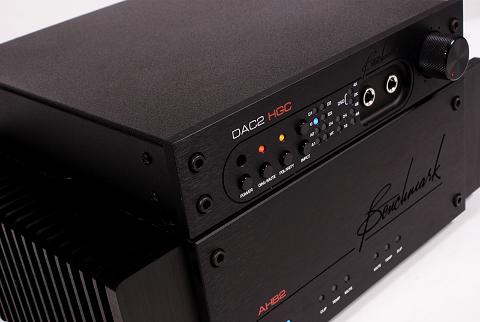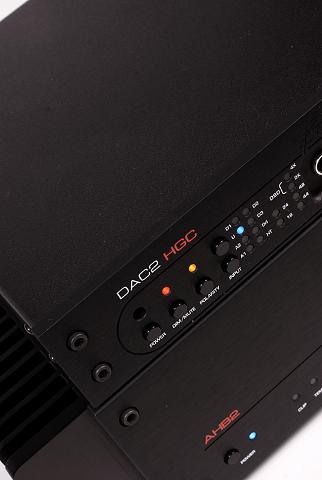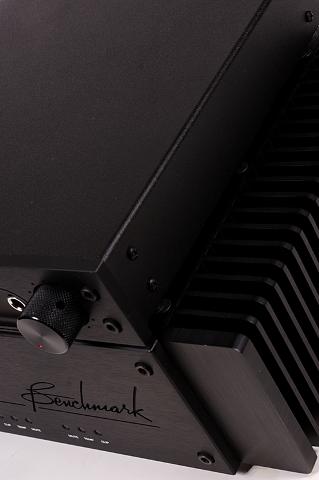about Audio, High Fidelity
& Home Entertainment technologies
pid: 605-2025/09/17 (v1.2)
Privacy Policy

For the listening test, DAC2 HGC and AHB2 replaced our regular reference preamplifier and power amplifier (Melos Plus Series Line and Parasound HCA3500) to drive the ATC SCM50PSL loudspeakers with the Teac P70/D70 CD transport/DAC as a source. Signal transfer between the preamplifier and the power amplifier was via balanced cables and the standard binding posts were used to connect the loudspeakers, despite the fact that Benchmark recommends that Speakon connection as a better choice. The initial installation poses no problems, on the contrary, the compact size of the two devices will facilitate the user who faces some space constraints.
Replacing the reference amplifiers with the Benchmark devices introduced some interesting and significant changes in the system. The first impressions include a more clear, dimensionally stable and well-defined soundstage, a better performance on detail and a better feeling of macrodynamics of the listening material. The end result was effortless and uncompressed, with very good speed characteristics and a sense of balance. The lower power of AHB2, compared to the HCA3500, surfaced only in some extreme cases of the whole assessment scenario and surely involved the amplifier's rather provident clipping indicators, flashing long before any audible clipping or even compression appears. In general, HBA2 seemed much better in controlling the available power through the loudspeakers compared to the HCA3500. Most probably, anyway, a significant share of this better dynamic behavior should be attributed to DAC2 HGC in its role as a preamplifier. DAC2's very low noise level, low crosstalk, and good channel balance, are all related, possibly directly, to the better soundstage and detail description experienced from the system as a whole.
Low frequencies appeared comfortable, well extended and balanced while, in comparison, the reference amplifiers sounded somewhat exaggerated and larger-than-life in this part of the audio spectrum. In contrast, the Benchmark system seemed tighter and with a more strict character without depriving the listener of any details contained in the recording. In general, both good control and image scaling proved to be a strong feature of the amplifiers in the low-frequency range lacking any trace of artificial emphasis here. Big orchestras, large string instruments, and electronic, low-frequency rich, syntheses sounded impressive, well-defined and easily dominating the room. At the same time, the amplifiers preserved all of the details necessary to actually feel the acoustic space in the recording, without any significant clue that the electronics were somehow involved in the final result. Rhythm section parts reproduced effortlessly, with great speed, and a sense of fullness, without ever becoming excessive. It was really impressive that the amplifiers maintained a relaxed, comfortable character, even close to their limits (to be precise: the power amp limits), without any harshness or other unpleasant artifacts apart from a progressive feeling of compression which is expected. In practice, given a loudspeaker of typical sensitivity (let's say around 90dBSPL/w/m), AHB2 seemed quite capable of supporting a medium-to-large listening geometry, offering a more than enough listening level headroom.
These attributes, of transparency and comfort, which defined the low-frequency behavior of the amplifiers, were maintained, as one would probably expect, towards the midrange. Here, both detail and clarity are more important and the Benchmark pair showed to have no difficulties at all. The overall soundstage is focused slightly behind the horizontal axis connecting the loudspeakers and the listener is, always, faced with a detailed sound field. Stereo imaging is clear, well defined in space, with very good resolution and a sense of transparency and good depth. Voices feature very good articulation and detail and the overall presence is very realistic, both in small orchestras and solo voices and in larger scale projects and choirs. It is obvious that the design of the amplifiers is done with some "good monitoring" values in mind, like tonal accuracy and a coherent soundstage. In this case, good channel balance and good microdynamics seemed to have played a role: Individual audio objects were clearly focused, and both the sense of space and movement described in the recording were preserved in the listening room. Compared with the DAC2 HGC/AHB2 system, the reference amplifiers sounded a bit vaguer and atmospheric (this, despite the fact that, in general, they offer some very good stereo imaging attributes).
Towards the high-frequency part of the audio spectrum, the DAC2 HGC/AHB2 combination sounded quite pleasant -but without being intentionally soft or euphonic- and offered a very well balanced feeling of brightness and wide bandwidth. From the listener's point of view, the result is a restful character, without any trace of harshness. The overall impression is that the system is able to pass into the listening room both the harmonic richness and the tonal balance of the recording. The Benchmark pair offered near-flawless attack/release times and sounded full and impressively present even in small details, a behavior that reinforces the sense of precision and carries the listener a step closer to the live performance.
Conclusion
While the DAC2 HGC is a, pretty much, well-known device, the AHB2 proved to be a very pleasant surprise, indeed. Benchmark dared to engage their power amplifier project from a different angle, discarding the standard approach (i.e the use of a conventional linear or switch-mode output stage) and certainly succeeded. The theoretical advantages of their choices are both evident in the laboratory and heard during the listening sessions, thus justifying the whole approach. Overall, the DAC HGC/AHB2 pair is the best preamplifier/power amplifier we had the opportunity to listen to in recent years in this price range, and the general feeling is that it will successfully confront many of the traditional choices in this particular market segment. Given the fact the DAC2 HGC is also a high-quality DAC and headphone amplifier, all you have to do, to assemble a really well respected audio system, is to connect a good pair of loudspeakers and a media player of some sort. Highly recommended!
Previous | Next | More Reviews



